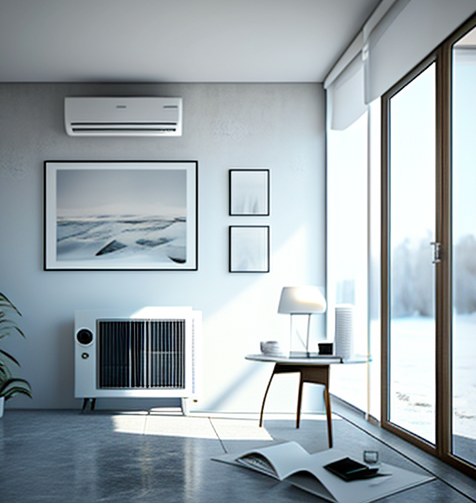The Pros And Cons Of Ductless Mini-Split Ac Systems
The installation of a ductless mini-split AC system is an increasingly popular choice for many homeowners. This type of air conditioning solution offers numerous advantages as well as potential drawbacks, which should be considered before making the decision to invest in such a system.
This article will explore the pros and cons of using a ductless mini-split AC system, providing readers with an informed review to help them make an educated decision about this type of home cooling technology.
The use of ductless mini-splits has been growing exponentially over recent years due to their efficiency and convenience in comparison to traditional HVAC systems. Despite their increasing popularity, there are still some important considerations that need to be taken into account when deciding whether or not this kind of air conditioning solution is right for you and your home.
By examining both the benefits and disadvantages associated with these types of systems, it is possible to determine if they are suitable for your individual needs.
Cost Of Installation
When considering ductless mini-split AC systems, one of the most important factors to consider is installation complexity and costs. Such systems require a professional HVAC technician for installation, which can be difficult depending on the layout of the property. However, due to their flexibility in terms of setup and placement, they are often more simple to install than traditional central air conditioning systems.
In addition to potential difficulty installing these systems, costs associated with such installations may vary greatly depending on several factors. The size of the unit needed as well as any additional components necessary for operation will all impact the total cost for installation.
Furthermore, labor charges associated with installation differ from region to region and between technicians so it’s important to do some research prior to selecting an installer. Ultimately, while ductless mini-split AC systems may have higher upfront costs than other types of cooling solutions due to their specialized parts and complex installation requirements, they offer many benefits that make them a worthwhile investment in comfort and energy efficiency over time.

Energy Efficiency
The energy efficiency of ductless mini-split AC systems has become increasingly attractive to homeowners. With the average yearly cost for running a system estimated at around $250, it is much cheaper than traditional air conditioners and can even lead to significant savings in monthly utility bills when compared with other central cooling systems.
Furthermore, energy savings are further enhanced by the ability of these units to provide climate control without having to cool down entire rooms or buildings that may not be used as frequently – this ensures only the necessary areas are cooled and no energy is wasted.
In addition to their impressive energy-saving capabilities, many models offer additional features such as automated temperature settings, adjustable timers, and humidity sensors for home comfort year round.
The technology involved also makes them quieter than traditional air conditioning systems, allowing for more comfortable living spaces free from intrusive noise levels. This added benefit enables users to enjoy consistent temperatures while enjoying peace and quiet throughout the day and night.
Extended Lifespan
The extended lifespan of ductless mini-split AC systems is a major benefit, as it allows for long term savings. The lack of air ducts means that these systems are not subject to the same wear and tear as traditional HVAC systems, which can experience damage due to rodents, dust mites, or other debris. Furthermore, since there are no exposed parts within the unit itself, the system is better protected from environmental elements such as moisture or temperature extremes.
This longevity also ensures improved indoor air quality, as clean filters will continue to be effective in trapping allergens and pollutants over time.
In terms of room coverage, ductless mini-split AC systems offer greater flexibility when compared to central units. With multiple heads installed around the house – up to four per outdoor condenser – you can easily adjust the cooling levels throughout an entire home without needing to purchase additional equipment.
Additionally, each head can be individually operated with a remote control device so that users can customize their comfort levels even further by controlling individual rooms’ temperatures independently from one another. As such, this type of system provides efficient energy management while still offering personalized comfort settings for occupants across any property size.
Easy Temperature Control
Ductless mini-split air conditioning systems offer a level of temperature control that is superior to traditional centralized air conditioning.
This type of system allows users to set different temperatures in multiple areas, or zones, within their home.
Zone flexibility enables homeowners to customize the climate in each room and area based on individual preferences or needs.
Moreover, since ductless mini-splits are installed without extensive modifications to existing structures, installation complexity can be minimized compared to other types of cooling systems.
As a result of these advantages, ductless mini-split ac systems have become increasingly popular among consumers looking for greater comfort and convenience.
In addition to providing an easy way to control the temperature inside any space, they are also more energy efficient than conventional central air conditioners due to their ability to cool only designated spaces instead of the entire house at once.
Limited Capacity
The limited capacity of ductless mini-split AC systems is a notable disadvantage of this type of cooling system.
Although they are well-suited to rooms with limited space, the size and power restrictions inherent in these units can make them unsuitable for larger areas.
This limitation means that additional units may be required to effectively cool an entire home or building – leading to higher installation costs than would normally be expected from traditional HVAC solutions.
Furthermore, depending on the model chosen, some ductless split AC systems are more expensive than their centralized counterparts due to the cost associated with individual unit components such as compressors and evaporator coils being necessary for each area requiring climate control.
Maintenance Requirements
Maintaining a ductless mini-split AC system is relatively straightforward and simple. Accessibility issues make it easy to check, clean, or repair the indoor unit without having to crawl into tight attic spaces as with traditional systems.
The outdoor component of the system is usually placed away from any living areas which makes servicing it easier than other types of air conditioning units. Indoor placement also eliminates some common problems that come with centralised air conditioners such as noise generation in living spaces and the need for separate filters for each room.
As there are no ventilation ducts required with this type of system, energy losses associated with leaks can be avoided altogether. Additionally, since only one outdoor compressor serves multiple indoor units, energy consumption is reduced compared to centralized systems where every room requires its own compressor.

Potential For Noise
The potential for noise should be considered with the installation of ductless mini-split AC systems. The sound insulation must be taken into account to ensure that these systems are operating at acceptable levels or below accepted noise regulations. This can be accomplished by utilizing certain techniques such as installing a unit in an enclosed space, placing it away from living spaces and ensuring proper installation of ductwork and other components.
It is also important to note that some models may have higher noise levels than others due to their design. Therefore, research should be done prior to purchase on the specific model being considered in order to determine what kind of noise output it produces when running so that appropriate measures can be taken before any installation begins.
Additionally, professional installers typically offer assistance with choosing products based on their experience with various brands and models which could help reduce risk associated with potentially loud units.
In summary, careful consideration needs to be given for both the placement and selection of ductless mini-split AC systems in order to make sure they operate within acceptable standards for noise level production.
Conclusion
The ductless mini-split AC system is an energy efficient option that can be easily installed in most homes. It has a long lifespan and allows for temperature control with ease.
However, it may not be the best choice for larger spaces as its capacity is limited. Additionally, regular maintenance of the unit will be necessary to ensure proper performance and minimize potential noise issues.
All factors should be taken into consideration when determining if this type of AC system is the right choice for one’s residence or business. Ultimately, weighing the pros and cons of installing this type of cooling system can help make an informed decision that meets individual needs while meeting budget requirements.







